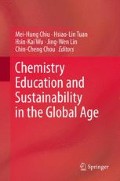Abstract
This chapter focuses on junior college students’ academic achievement and learning attitudes after exposure to an ICT-integrated experimental chemistry course. This study adopted the quasi-experimental approach and divided students into two groups. Aided by ANCOVA data, this study probed students’ chemical learning effects and attitudes in detail. Major results indicate what assessments of students’ ICT-integrated learning can be achieved and upgraded at the initial level by a NSC-funded project. Presentations of students’ ICT performances can be analyzed and implemented at the module level.
Access this chapter
Tax calculation will be finalised at checkout
Purchases are for personal use only
References
Ardac, D., & Akaygun, S. (2004). Effectiveness of multimedia-based instruction that emphasizes molecular representations on students’ understanding of chemical change. Journal of Research in Science Teaching, 41(4), 317–337.
Ardac, D., & Sezen, A. H. (2002). Effectiveness of computer-based chemistry instruction in enhancing the learning of content and variable control under guided versus unguided conditions. Journal of Science Education and Technology, 11, 39–48.
Ausubel, D. P. (1968). Educational psychology: A cognitive view. New York: Holt, Rinehart & Winston.
Calik, M., & Ayas, A. (2005). A comparison of level of understanding of grade B students and science student teachers related to selected chemistry concepts. Journal of Research in Science Teaching, 42(6), 638–667.
Coll, R., & Treagust, D. (2001). Learners’ use of analogy and alternative conceptions for chemical bonding: A cross-age study. Australian Science Teachers’ Journal, 48(1), 24–32.
Frailich, M., Kesner, M., & Hofstein, A. (2007). The influence of web based chemistry learning on students’ perceptions, attitudes, and achievement. Research in Science and Technological Education, 25(2), 179–197.
Hofstein, A., & Lunetta, V. N. (2004). The laboratory in science education: Foundations for the twenty-first century. Science Education, 88, 28–54.
Katerina, S., & Tzougraki, C. (2004). Attitudes toward chemistry among 11th grade students in high schools in Greece. Science Education, 88, 535–547.
Keengwe, J., Onchwari, G., & Wachira, P. (2008). Computer technology integration and student learning: Barriers and promise. Journal of Science Education and Technology, 17, 560–565.
Lin, H. S. (1998). The effectiveness of teaching chemistry through the history of science. Journal of Chemical Education, 75(10), 1326–1330.
Lin, H. S., Hung, J. Y., & Hung, S. C. (2002). Using the history of science to promote students’ problem-solving ability. International Journal of Science Education, 24(5), 453–464.
Moreno, R., & Valdez, A. (2005). Cognitive load and learning effects of having students organize pictures and words in multimedia environments: The role of student interactivity and feedback. Educational Technology Research and Development, 53(3), 35–45.
Nakhleh, M. B. (1993). Are our students’ conceptual thinkers or algorithmic problem solvers? Journal of Chemical Education, 70(1), 52–55.
Rodriguez, M. A., & Niaz, M. (2002). How in spite of the rhetoric, history of chemistry has been ignored in presenting atomic structure in textbooks. Science & Education, 11, 423–441.
Su, K. D. (2008a). An integrated science course designed with information communication technologies to enhance university students’ learning performance. Computers & Education, 51, 1365–1374.
Su, K. D. (2008b). The effects of a chemistry course with integrated information communication technologies on university students’ learning and attitudes. International Journal of Science and Mathematics Education, 6, 225–249.
Su, K. D. (2011). An intensive ICT-integrated environmental learning strategy for enhancing student performance. International Journal of Environmental and Science Education, 6(1), 39–58.
Trumper, R. (1997). Applying conceptual conflict strategies in the learning of the energy concept. Research in Science and Technology Education, 5, 1–19.
Yang, E. M., & Andre, T. (2003). Spatial ability and the impact of visualization/animation on learning electrochemistry. International Journal Science Education, 25, 329–349.
Yore, L. D. (2001). What is meant by constructivist science teaching and will the science education community stay the course for meaningful reform? Electronic Journal of Science Education, 5(4). Online journal: http://unr.edu/homepage/crowther/ejse
Yore, L. D., & Treagust, D. F. (2006). Current realities and future possibilities: Language and science literacy empowering research and informing instruction. International Journal of Science Education, 28, 291–314.
Acknowledgment
The author would like to thanks editors of this book and the anonymous reviewers of this paper for their kind assistance and helpful suggestions. A short but sincere thank you must also be given for the patronage of the National Science Council, R.O.C in Taiwan (under grant No. NSC 95-2511-S-237-001 and NSC 98-2511-S-237-001). Without their help, our study could not have been completed. Finally, thanks must also be given to all the teachers and students who participated in this research study.
Author information
Authors and Affiliations
Corresponding author
Editor information
Editors and Affiliations
Rights and permissions
Copyright information
© 2013 Springer Science+Business Media Dordrecht
About this chapter
Cite this chapter
Su, KD. (2013). An Integrated-ICT Assessment for College Students’ Performances of Chemical Learning. In: Chiu, MH., Tuan, HL., Wu, HK., Lin, JW., Chou, CC. (eds) Chemistry Education and Sustainability in the Global Age. Springer, Dordrecht. https://doi.org/10.1007/978-94-007-4860-6_21
Download citation
DOI: https://doi.org/10.1007/978-94-007-4860-6_21
Published:
Publisher Name: Springer, Dordrecht
Print ISBN: 978-94-007-4859-0
Online ISBN: 978-94-007-4860-6
eBook Packages: Humanities, Social Sciences and LawEducation (R0)

